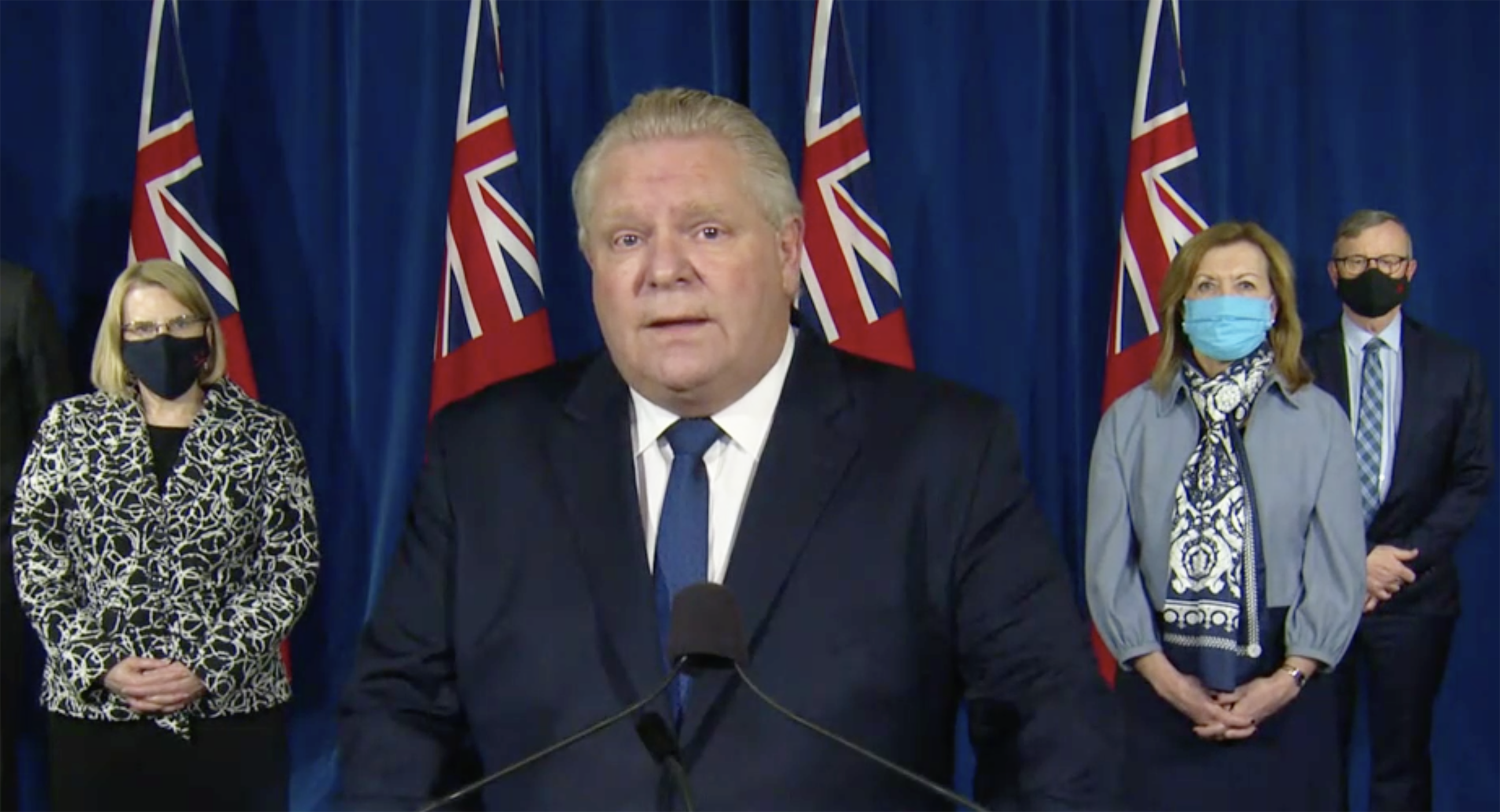TORONTO – As expected, the Ontario government has announced the current stay-at-home order has been extended until at least June 2.
“The situation is slowly trending in the right direction,” said Premier Doug Ford on May 13. “Make no mistake; we’re not out of the woods yet.”
Added Ford, “We must stay vigilant to ensure our ICU numbers stay down and our hospital capacity is protected. If we stay the course for the next two weeks, and continue vaccinating record number of Ontarians every day, we can begin looking forward to July and August and having the summer that everyone deserves.”
The current stay-at-home order was introduced on April 8 for six weeks to control the third wave of COVID-19. According to data from the province, the order appears to be working.
From May 2-8, the provincial cases rate decreased by 14.8 per cent, with the positivity rate also decreasing to 7.7 per cent from 8.6 per cent. The number of patients with COVID-related critical illness in intensive care decreased from 877 on May 5 to 776 on May 12.
Despite the decreased numbers, which are comparable to the province’s numbers at the peak of the second wave, Ontario’s chief medical officer of health said the restrictions need to remain in place.
The provincial cases rate remained “very high” at 134.9 per 100,000 people, and per cent positivity was above the “high alert” threshold of 2.5 per cent. The doctor also said hospitalization and intensive care unit admissions remain too high and well above the peak of the second wave.
“We all must remain vigilant, as we are not yet at the point where we can safely exit the stay-at-home order, as our health system remains under significant strain,” said Dr. David Williams. “By continuing to strictly follow all measures, we can further reduce transmission of the virus, safeguard hospital and public health capacity, and save lives.”
Ford stated the province could lift restrictions on outdoor recreation by June 2 if trends continue the way they are.
When asked why outdoor recreation, such as golf courses, are not allowed to open despite pressure from mayors and doctors across the province, both Ford stated it’s not the activity, but rather the “before and after” events that are the issue.
“I talk to my buddies, I know what happens… they pick up another buddy, they go out golfing. There’s nothing wrong with golfing, it’s the mobility. And after golf, they go back and have a few pops,” said Ford. “That’s the problem.”
Vaccines
Ford announced Thursday that beginning the week of May 31, youth in Ontario between the ages of 12 and 17, and their family members who have not received a vaccine, will be eligible to book an appointment to receive their first dose of the Pfizer vaccine.
There are also plans for dedicated youth and family vaccine clinics during the weeks of June 14 and June 21.
The province also stated they will work with public health units to offer both doses of the vaccine to youth between the ages of 12 and 17 by the end of August, in collaboration with school boards and other partners.
Schools to continue remote learning
With the extension of the stay-at-home order, schools will continue to operate under teacher-led remove learning.
When asked if there was a chance that schools would open in June, Ford didn’t provide a clear answer but did state the “docs” and union leaders need to come up with a solution.
“We have some doctors that are saying yes, but then we have the teacher union that wants to potentially put an injunction against us, against opening the schools,” said Ford. “I just need the labour leaders to sit down with the docs and come up with a solution.”
On Tuesday, the Elementary Teachers Federation of Ontario, in a press release, called on the government again to provide more funding to keep schools safe.
“Throughout the pandemic, ETFO has advocated strongly for publicly funded schools to remain open safely and sustainably because we know in-person learning is the most equitable experience for learners. But this must not be done at the expense of well-being,” states the release.
Among the union’s requests to the province are the lowering of class sizes, evaluate and improve ventilation with CO2 monitors, and increase funding to ensure infection control requirements in schools are met.
On Thursday, Williams told reporters that he had spoken to local medical officers of health throughout the province. Some stated they are comfortable with schools reopening.
“We are going to have to have some more discussions, with our local health units and with the Ministry of Education, on when the best time and the right time (is to reopen),” said Williams.
“We want them to open and stay open.”
Tougher border restrictions
Ford also took an opportunity to express his dissatisfaction with the federal government’s handling of the country’s borders.
On May 12, Ford released a letter written to Prime Minister Justin Trudeau requesting improved COVID-19 measures at the border, including:
- reducing the number of international flights coming to Canada, particularly Ontario;
- mandatory COVID-19 tests for domestic travellers; and
- requiring those crossing at a land border to spend three days in a quarantine hotel.
The premier said this is the fourth letter he has sent Trudeau asking for various measures to be implemented, without any response from the federal government.
Ford stated that the B117 variant, commonly referred to as the “UK variant,” is now the dominant strain in Ontario, accounting for almost all new infections.
“Existing measures at the border, an area of federal responsibility, failed to keep variants of concern out of Canada. These variants entered our province through our borders and, as a result, have had devastating impacts on our communities,” Ford said.
Trudeau has responded that the federal government is awaiting information from the province on what specific travel Ontario wants to see restricted.




